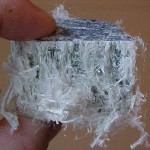 Earlier, I wrote about some potential similarities between asbestos personal injury litigation and the litigation that is certain to come over nanoparticles and human health. I will be writing on and off about this topic going forward as well. I can’t emphasize enough the urgency of avoiding another disaster like asbestos litigation, which has clogged the courts since the 1970s.
Earlier, I wrote about some potential similarities between asbestos personal injury litigation and the litigation that is certain to come over nanoparticles and human health. I will be writing on and off about this topic going forward as well. I can’t emphasize enough the urgency of avoiding another disaster like asbestos litigation, which has clogged the courts since the 1970s.
For example, engineered nanomaterials are being placed into building materials. In the first instance, these materials are being designed and manufactured in the primary workplace environment, thus potentially exposing workers to hazards about which little or nothing is known. Another set of workers, those using the building materials in the secondary workplace, run the risk of exposure to potentially harmful substances.
The history of asbestos shows that the early studies were conducted on asbestos textile factory workers, but that meaningful studies on workers out in the field who were installing the materials lagged far behind. Then, when the studies began to raise danger signals, the industry ignored those signals until the specter of mass litigation and government regulation forced recognition. By then it was too late.
Nanomaterials present some of the same workplace issues, particularly when used in building materials. The hazards of the primary workplace may be different from those in the secondary workplace. Studies must be conducted on both types of environments.
Further, there is a third concern, which also mirrors the asbestos experience. At some point down the line (years or decades), the anticipated life of the materials will expire, just as asbestos insulation materials have done. At that point, degeneration of the materials could put nanomaterials into the environment to a degree that could endanger the safety of persons in the vicinity.
In the case of nanomaterials, do we know any of this for certain? No. But at the present time we know almost nothing about any of these safety issues. In December, the National Institute for Occupational Safety and Health (NIOSH) proposed a workplace exposure limit for carbon nanotubes and nanofibers. This is a start; but without hard data, it is really only a guess. And it is not necessarily consistent with limits for other substances.
While the industries creating and using nanomaterials will likely take seriously the lessons of asbestos, more should be done up front to ascertain the seriousness and scope of the hazards that the materials may present. Now is the time. If the hazards outrun the studies, the finish line will be litigation.

Asbestos should not be in homes, buildings, etc.! The stuff is poison, check out the EPA http://www.epa.gov/asbestos/pubs/help.html and this site http://www.weitzlux.com/asbestos_1962542.html